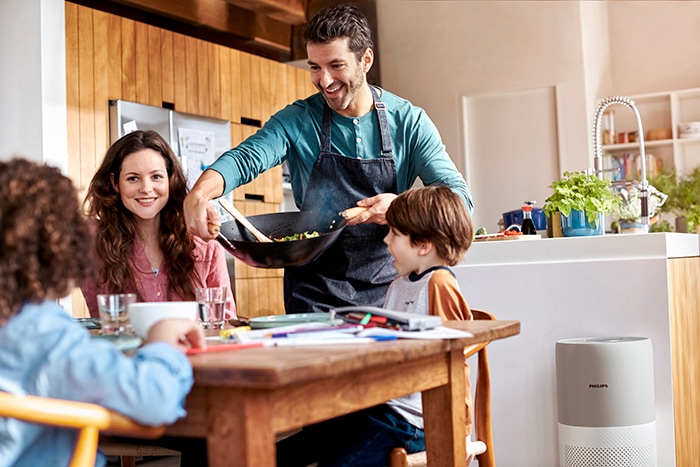For years, there’s been a clear trend that people are becoming more and more conscious of the quality of the air they breathe – whether at home, at the office or school. The rapid rise and global spread of the COVID-19 pandemic, which accounts for more than 27 million COVID-19 cases worldwide, burdening health systems and societies, has made people even more conscious of air quality. Preventative measures were implemented, such as social distancing, mask-wearing, and personal hygiene protocols, to mitigate the widely recognized transmission via larger respiratory droplets and direct contact with infected people or contaminated surfaces [1]. In addition to these preventative measures, the conversation has recently expanded to ventilation and clean air delivery in connection with the possible airborne transmission via SARS-CoV-2 aerosols, as prompted by key opinion leaders in their open letter [2] to the WHO in July 2020. This is an especially relevant topic for those living in the Northern Hemisphere as the seasons change to cooler temperatures, and people move indoors.

Philips is teaming up with experts in the field to study the impact of air purification on indoor virus aerosol levels. The WHO calls for further studies on airborne transmission [3]; meanwhile, engineering, environmental and air/ventilation experts point to existing evidence that COVID-19 is also airborne and that there is a need for increased ventilation and particle filtration used in conjunction with other measures like social distancing to reduce the risk of airborne transmission [2][4]. Indeed, there's still a need for further, global, clinical research to determine how aerosols impact coronavirus transmission. In parallel, Philips plans to verify its devices' efficacy specifically at filtering SARS-CoV-2 from the air. With a team of more than 100 scientists, doctors and engineers working in air purification, Philips has a long-standing heritage in health tech and has become a global leader in air purification. The company’s newest line of home air purifiers features a smart air quality sensor that continuously scans the indoor air 1000 times per second to detect fine-dust levels and removes ultrafine particles, dust, pollen, gases, bacteria and viruses. The digital display shows real-time indoor air quality levels, and the built-in connectivity allows the user to control and monitor the device with the Philips Clean Home+ App. The 360-degree air circulation system can purify the air in a 20m2 room in less than six minutes [5]. While Philips air purifiers have not been verified to remove SARS-CoV-2 aerosols from the air – Philips' HEPA filters can remove 99.97% of particles as small as 0.003μm [6] (equal to 3 nm), smaller than the smallest known virus [7], from the air that passes through the filter. A similar performance is expected for SARS-CoV-2 aerosols. An independent institute tested that Philips’ air purifiers can reduce the levels of Influenza A (H1N1) virus aerosols by 99.9% in a test chamber, within ten minutes after being turned on [8].
We’re using our innovation power and international network to determine how air purifiers can contribute to a healthier, cleaner indoor air environment.
Eugene de Lannoy
Philips Business Leader Home Care
"As we have seen an increasing demand for our air purifiers – we’re using our innovation power and international network to determine how air purifiers can contribute to a healthier, cleaner indoor air environment," said Eugene de Lannoy, Philips Business Leader Home Care. "As we did with the H1N1 virus, we’ve started working with renowned partners to demonstrate the effectiveness of our air purifiers to remove coronavirus aerosols. While we know air purification won’t be the only solution to reducing aerosol spread, like the U.S. EPA, we are convinced that air purifiers could be part of a broader protection plan against COVID-19. Air purifiers can help to improve the air quality in homes, schools, offices and other public spaces.”
[1] Q&A: How is COVID-19 transmitted?, World Health Organization, July 2020 [2] Lidia Morawska, Donald K Milton, It is Time to Address Airborne Transmission of COVID-19, Clinical Infectious Diseases, ciaa939, https://doi.org/10.1093/cid/ciaa939 [3] Transmission of SARS-CoV-2: implications for infection prevention precautions, World Health Organization, Scientific Brief, July 2020 [4] How can airborne transmission of COVID-19 indoors be minimised?", Environment International, Volume 142, September 2020, ISSN 0160-4120, [5] From the air that passes through the filter, it is a theoretical time for one-time cleaning calculated by dividing its CADR 500m3/h by the room size of 48m3 (assuming the room is 20 m2 in floor area and 2.4m2 in height) [6] IUTA report UN2-170928-T5599900-100.2 - Measurement of the deposition efficiency of FY3433 type filter for 3 nm NaCl particles [7] Chen et al, 2020. Epidemiological and clinical characteristics of 99 cases of 2019 novel coronavirus pneumonia in Wuhan, China: a descriptive study. Lancet, 395(10223): 507-513 [8] Microbial Reduction Rate Test conducted at Airmid Healthgroup Ltd. tested in a 28.5m3 test chamber contaminated with airborne influenza A(H1N1). According to the U.S. EPA, an air purifier by itself does not protect against COVID-19 but can be part of plan to protect yourself and your family.

Share on social media
Topics
Contact

Laura Seikritt
Philips Global Press Office Tel.: +31 6 20740318
You are about to visit a Philips global content page
Continue
